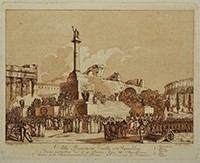When Rome spoke French: Festivals and monuments in the First Roman Republic
Roma, Museo Napoleonico
11 December 2015 – 13 March 2016
The twenty months of the Roman Republic 1798-99, though distinguished by many contradictions, represent for the city a moment of a complete break with the past, providing Rome with political and administrative structures and a political life totally unlike anything that had gone before.
In particular, the republican government felt it necessary to invent new public ceremonies. For these essentially Roman adaptations of French ceremonies, they came up with detailed programmes rich in symbols and remembrances redolent of the republican centuries of ancient Rome, for which architects, painters, and sculptors realised significant ephemeral decors.
The visual record of these events, today preserved almost exclusively in drawings and prints held at the MUSEO NAPOLEONICO, is shown here to the public in the exhibition “QUANDO ROMA PARLAVA FRANCESE. Feste e monumenti della prima Repubblica Romana (1798-1799) nelle collezioni del Museo Napoleonico”, from 11 December 2015 to 13 March 2016.
This is a unique display and the large quantity of preparatory material held makes it possible to get a remarkable impression, almost like a virtual visit to the engraver's studio, following the creative process from the preliminary sketch, through the different states up to the final print. The great rarity of this collection public and private of highly political illustrations is probably due to the fact that the Restoration put a great deal of energy into destroying copies where they found them.
The collection, which has only been partially visible to the public until now, contains works by confirmed Jacobins such as David-Pierre Humbert de Superville, Giuseppe Ceracchi, Sebastiano Ittar and Paolo Bargigli, all driven into exile after the fall of the republic, as well as artists who continued to work in the city for the Pope, namely the architect Giuseppe Camporese and the engraver Tommaso Piroli.
The exhibition is arranged in two rooms. Alongside the graphic works are shown a very rare series of pendants with revolutionary symbols, never before exhibited in Italy, made with the specifically Roman technique of micromosaic.
The exhibition catalogue edited by Marco Pupillo contains a complete list of all the objects of this sort held in the museum and an essay by Maria Grazia Branchetti, renowned expert on micromosaic.
More information (in Italian): Museo Napoleonico
Have a look at a few images on our facebook page.
Address
Piazza di Ponte Umberto I,
1 – 00186 Roma, Italy
Opening times
Tuesday- Sunday 10am-6pm
Free entrance
Audioguide to the permanent museum (Italian, French or English)
4 euros
Langue(s) : Italian


